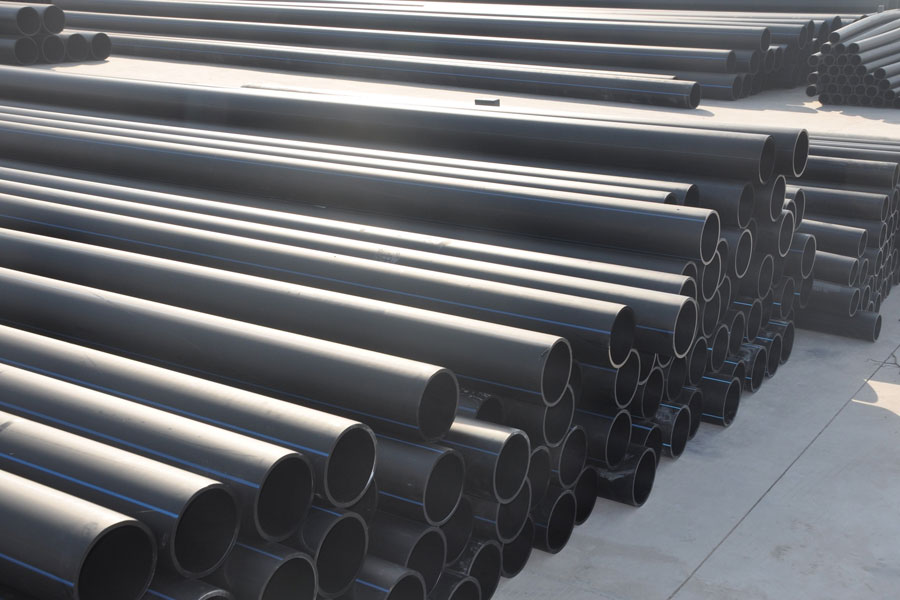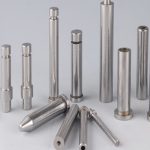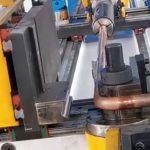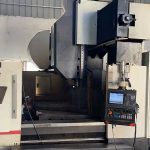In the extrusion molding of traditional thermoplastic pipes, the melt flow direction is parallel to the pipe axis, and the plastic macromolecular chains in the pipe wall are oriented parallel to the pipe axis. The strength of the pipe wall is greater in the axial direction than in the circumferential direction. The circumferential direction is twice the axial direction, so the axial and circumferential strength is contrary to the axial and circumferential stress. Thermoplastic pipe extrusion coating molding rotates the melt flow direction to be close to perpendicular to the pipe axis. The plastic macromolecular chain is mainly oriented along the pipe circumferential direction, making the plastic pipe circumferential strength greater than the axial direction, making the axial and circumferential directions The strength and force are consistent.

1 Introduction
The invention of thermoplastic pipes has a history of more than 70 years. The variety, dosage, application technology and manufacturing technology of plastic pipes have all made amazing progress.
However, in the extrusion molding of traditional thermoplastic pipes, the flow direction of the plastic melt is parallel to the axis of the pipe, and there has been basically no change for more than seventy years. The disadvantage of this action is that the plastic macromolecular chains in the pipe wall are oriented parallel to the pipe axis, and the strength of the pipe wall is greater in the direction parallel to the pipe axis than perpendicular to the pipe axis. This is exactly the opposite of the force on the pipe wall when the pressure-bearing pipe is subjected to internal pressure. According to the stress analysis of the pressure-bearing pipe, when the pipe is under internal pressure, the stress generated in the pipe wall along the circumference is about twice the stress generated in the pipe wall parallel to the pipe axis.
Originally, the strength of plastic is much lower than that of metal. The direction of higher plastic strength is not used on the circumferential pipe wall where the strength of plastic pipes is high, but falls on the axial direction with relatively low strength requirements. The existence of the phenomenon is undoubtedly a great waste. Different plastics have different magnitudes of this anisotropy. For example, TLCP, which is the easiest to orientate, when injection molding is used, the strength parallel to the melt flow direction is as high as about three times that of perpendicular to the melt flow direction. That is to say, TLCP with a strength of 150MPa, when the pipe is manufactured by the traditional extrusion molding method, its usable strength is less than 50MPa.
Chinese patent CN101332667A discloses a long glass fiber reinforced plastic pipe extrusion head, and specifically relates to a plastic round pipe extrusion head which is installed on a plastic extruder and has the characteristics of on-line spiral compounding of long glass fibers. The device has the input of glass fiber and the mixing and distributing device of fiber and melt and the mandrel rotating device. The mixing and distributing device of the handpiece successfully input a certain length of glass fiber treated with coupling agent into the plasticized plastic melt. And make the glass fiber evenly mixed into it to become a fiber-plastic mixed melt. The mandrel rotating device of the die realizes the transition of the melt flowing between the mandrel and the die from flowing along the axis of the mandrel to flowing around the mandrel in a spiral direction until it solidifies. In the plastic pipe extruded by the above device, polymer molecules and long glass fibers are oriented along the spiral direction of the axis, which greatly improves the circumferential strength of the pipe.
However, the circumferential arrangement of the long glass fibers in the above-mentioned plastic pipe is realized by the rotation of the mandrel in the die, which requires additional driving power and corresponding transmission devices (such as mandrel speed adjustment sprocket, mandrel rotation transmission chain Wheel support, mandrel rotating transmission chain, rotatable mandrel and transmission driven sprocket), not only consumes energy but also has a complicated head structure; in addition, one of the insurmountable drawbacks of the above device is that the melt rotates with the mandrel and is In the process of gradually pushing out the die and cooling and shaping, there is a rotating stress in the tube blank. Therefore, in addition to the linear motion of the tube, a kind of unnecessary rotating motion is added, and the rotating stress will be frozen in the tube wall. This is not allowed by the extrusion molding of all thermoplastic plastic pipes; in addition, the melt temperature of most plastic extrusion processing is about 200 ℃, some even as high as about 400 ℃, the melt pressure of the plastic in the extrusion process As high as several megapascals to tens of megapascals, the pressure of the polymer melt filled with glass fiber is bound to be higher, which makes the sealing between the core rod and the bearing seat very difficult, which is likely to cause melt leakage and affect the normal operation of the equipment. And increase the labor intensity of the operator, and sometimes even lead to equipment damage and other situations.
2. Extrusion coating molding of thermoplastic pipes
It is mainly used for the molding of thermoplastic pipes. The traditional method is extrusion molding. As mentioned above, during the extrusion molding process, the melt flow direction is parallel to the pipe axis, and the macromolecular chain is also oriented parallel to the pipe axis. The strength of the pipe wall is greater than perpendicular to the pipe axis. In order to improve the performance of plastic pipes and give them new functions, the outer surface of plastic pipes is often modified to improve the strength, toughness, elastic modulus, or oxygen resistance, anti-static and electrical conductivity, flame retardancy, etc. of plastic pipes. . In the traditional extrusion coating method, the direction of melt flow is also parallel to the axis of the pipe.
In order to change this backward technology, Manrui De Automation System Co., Ltd. applied for a PCT patent and was authorized by the United States, as shown in Figure 2. Using this patented technology, during the extrusion process of plastic pipes, the melt flow direction is changed from parallel to the pipe axis to perpendicular to the pipe axis, and the orientation of the plastic macromolecular chain is also changed from parallel to the pipe axis to perpendicular to the pipe axis. , And tangent to the circumference of the pipe, the strength of the pipe wall perpendicular to the pipe axis is greater than parallel to the pipe axis, and the fiber-reinforced thermoplastic pipe will also achieve a true reinforcement in the direction perpendicular to the pipe axis. This patent provides a key technology for changing the direction of melt flow, namely, an extrusion coating machine head containing a baffle plate and a plastic pipe coating molding device containing a coating machine head.
The two melt streams generated on both sides of the baffle flow in a clockwise and counterclockwise direction and are coated on the outer wall of the tube embryo formed by the core tube. The macromolecular chains of the thermoplastic are oriented along the circumference of the tube embryo. Under the action of the axial linear velocity applied by the tractor to the pipe, the two melt streams will form a cross arrangement, and the crossing angle is determined by the traction speed and the melt flow rate.
Thermoplastic pipe extrusion coating molding device (2, raw material pretreatment device; 5, coating layer feeding extruder; 6, extrusion coating head; 7, sizing cooling device; 8, traction device; 9 , Finished tube coiling device; 10. Core tube extrusion molding machine)
Thermoplastic pipe extrusion coating molding is realized as follows: Two baffles are provided in the extrusion coating head 6 and are fed by two extruders. One baffle receives the melted and plasticized polymer melt from the extruder 10 and extrudes the core tube, and the other baffle receives the melted and plasticized polymer melt from the extruder 5 and extrudes it. Covering the core tube, the finished tube can be obtained after cooling and shaping.
The production process of thermoplastic pipes relies on the traction force of the tractor to lead the tube blank into the sizing cooling device. Under the traction force, the two opposite melt flows formed by the baffle will flow around the mandrel. The spiral trajectory is stretched to form a network, which can be called a cross compound. The size of the helix angle is determined by the ratio of the extrusion speed to the traction speed. The helix angle (cross compound angle) whose hoop strength is equal to twice the axial strength is the ideal angle. The finished tube in Figure 6 actually has a four-layer structure, and the macromolecular chains in the four layers are oriented along the circumference of the tube.
3. Application of thermoplastic pipe extrusion coating molding
TLCP has the characteristics of high strength, high modulus, high heat resistance, high impact resistance, high wear resistance, high flame retardancy, high barrier, corrosion resistance, low creep, low thermal conductivity, etc., and outstanding performance. However, its macromolecular chains are easily oriented, and the product’s anisotropy is serious, and the strength of the welded joint is very different from that of the non-welded joint, which limits the wide application of the product. TLCP pipes or TLCP/TP Alloy pipes are extruded and coated by thermoplastic pipe extrusion coating molding technology. The rod-shaped macromolecules of TLCP will be oriented nearly perpendicular to the axis of the pipe. This orientation will mainly be reflected in the circumferential strength of the pipe. On the other hand, and the disadvantages of low weld strength will be compensated by cross compounding.
3.1TLCP steam pipeline
When used to transport higher temperature steam, compared with metal pipes, it can save a lot of anti-corrosion and heat preservation costs, and has a long service life; compared with traditional extrusion molding methods, the pressure-bearing capacity of pipes can be more than doubled.
3.2TLCP crude oil gathering and transportation pipeline
Compared with metal pipes, it can save a lot of anti-corrosion costs, a lot of heat tracing and insulation costs, and has a long service life; compared with traditional extrusion molding methods, the pressure-bearing capacity of pipes can be more than doubled.
3.3TLCP/TPU alloy oil well pumping liner
can be adapted to the production of oil wells within 5000 meters, far exceeding the 2500 meters of UHMWPE liner and 3500 meters of PEX liner.
3.4TLCP/PO alloy oxygen barrier plastic pipe
Excellent water resistance, heat resistance, barrier performance, mechanical properties, etc., two-layer structure, performance exceeds the use of EVOH five-layer structure oxygen barrier plastic pipe, easy to recycle waste. (1, finished plastic pipe; 2. raw material processing device; 3. pipe feeding machine; 4. pipe surface preheating plasma treatment device; 5. extruder; 6. extrusion coating head; 7. shaping cooling device; 8. Traction machine; 9. Oxygen barrier plastic pipe coated with TLCP/PO alloy layer)
The line speed of the pipe feeder 3 and the pipe guide 8 are equal, and the semi-finished pipes that need surface modification or add new functions, such as PEXb pipes, PEXc pipes and synchronous cross-linked PEXa pipes that need to be coated with oxygen barrier layer, are placed in the semi-finished products. On the tube unwinding machine 1, the unwinding is dragged by the tube feeder 3 and the tube guide 8, and enters the tube surface treatment device 4 to treat the surface of the tube. The treatment method is plasma treatment, corona treatment, or flame treatment Then, the surface-treated semi-finished pipe enters the coating head 6 and merges with the polymer melt that has been melted and plasticized by the raw material processing device 2 and the coating layer extruder 5. In the coating head 6, the melt flows perpendicularly to the axis of the semi-finished pipe and flows counterclockwise along the tangent to the outer wall of the semi-finished pipe. After being coated on the outer surface of the semi-finished pipe, it enters the shaping cooling water tank 7 for cooling and shaping, and finally An oxygen barrier tube with an oxygen barrier layer modified by extrusion coating on the outer surface is obtained, and is collected on the finished product winder 9.
Using the device and TLCP/PE alloy, it is possible to manufacture the two-layer structure oxygen barrier PEX tube and the oxygen barrier PERT tube; using the device shown in Figure 7 and the TLCP/PP (or PB-1) alloy, the two-layer structure oxygen barrier PB-1 tube can be manufactured And oxygen barrier PP pipe, etc.
3.5 Multilayer structure pipe
When multi-layer extrusion coating molding, it is easy to realize the compounding of functional layers, such as drainage pipes in polyethylene pipes used in coal mines. The main performance and functional requirements of each layer are as follows:
Inner core tube: flame retardancy and abrasion resistance are mainly required. In order to reduce a large amount of flame retardants and reduce the mechanical properties of the inner tube, a small amount of non-flammable TLCP resin can be substituted for part of the high-density polyethylene resin, and the amount of flame retardant added is reduced. , HDPE is reinforced by TLCP, which also improves the wear resistance of the inner tube.
Intermediate layer pipe: Mainly requires flame retardancy and mechanical properties. More non-flammable TLCP resin can be used to replace high density polyethylene resin. The amount of flame retardant added is reduced, and HDPE is reinforced by TLCP.
Outer tube: Mainly requires flame retardancy and anti-static. In order to reduce a large amount of flame retardants and reduce the mechanical properties of the outer tube, a small amount of non-flammable TLCP resin can be used to replace part of the high-density polyethylene resin, and the amount of flame retardant added is reduced, HDPE It has been enhanced by TLCP, even if it is an antistatic agent that must be added, the impact on the mechanical properties of the outer tube will be greatly reduced.
In order to eliminate the increase in raw material costs caused by the addition of a large amount of TLCP, it is very effective and necessary to add whiskers to the formulation of each layer. In addition, it can also make the material strengthen, strengthen, toughen, increase the combustion temperature, and reduce the amount of smoke. And so on. Each layer is added with TLCP and whiskers. The circumferential strength of the multi-layer composite polyethylene pipe used in underground coal mines manufactured by the thermoplastic pipe extrusion coating molding device has been improved, and its wall thickness has been reduced. Reduce the cost of pipes.
4. Conclusion
Thermoplastic pipe extrusion coating molding changes the orientation of traditional extrusion molding macromolecular chains and overcomes the shortcomings of the CN101332667A rotating mandrel head. The device has no moving parts, no special sealing, and will not increase the failure rate of equipment; The melt flow goes clockwise and counterclockwise, the tube blank will not rotate, and there is no rotating internal stress; the circumferential strength of the tube is increased, and the pressure-bearing capacity of the tube is improved. This technology is suitable for the manufacture of most thermoplastic pipes.
Link to this article:Thermoplastic pipe extrusion coating molding
Reprint Statement: If there are no special instructions, all articles on this site are original. Please indicate the source for reprinting:https://www.cncmachiningptj.com/,thanks!
 3, 4 and 5-axis precision CNC machining services for aluminum machining, beryllium, carbon steel, magnesium, titanium machining, Inconel, platinum, superalloy, acetal, polycarbonate, fiberglass, graphite and wood. Capable of machining parts up to 98 in. turning dia. and +/-0.001 in. straightness tolerance. Processes include milling, turning, drilling, boring, threading, tapping, forming, knurling, counterboring, countersinking, reaming and laser cutting. Secondary services such as assembly, centerless grinding, heat treating, plating and welding. Prototype and low to high volume production offered with maximum 50,000 units. Suitable for fluid power, pneumatics, hydraulics and valve applications. Serves the aerospace, aircraft, military, medical and defense industries.PTJ will strategize with you to provide the most cost-effective services to help you reach your target,Welcome to Contact us ( [email protected] ) directly for your new project.
3, 4 and 5-axis precision CNC machining services for aluminum machining, beryllium, carbon steel, magnesium, titanium machining, Inconel, platinum, superalloy, acetal, polycarbonate, fiberglass, graphite and wood. Capable of machining parts up to 98 in. turning dia. and +/-0.001 in. straightness tolerance. Processes include milling, turning, drilling, boring, threading, tapping, forming, knurling, counterboring, countersinking, reaming and laser cutting. Secondary services such as assembly, centerless grinding, heat treating, plating and welding. Prototype and low to high volume production offered with maximum 50,000 units. Suitable for fluid power, pneumatics, hydraulics and valve applications. Serves the aerospace, aircraft, military, medical and defense industries.PTJ will strategize with you to provide the most cost-effective services to help you reach your target,Welcome to Contact us ( [email protected] ) directly for your new project.
Link to this article:Thermoplastic pipe extrusion coating molding
Reprint Statement: If there are no special instructions, all articles on this site are original. Please indicate the source for reprinting:Alloy Wiki,thanks!^^







